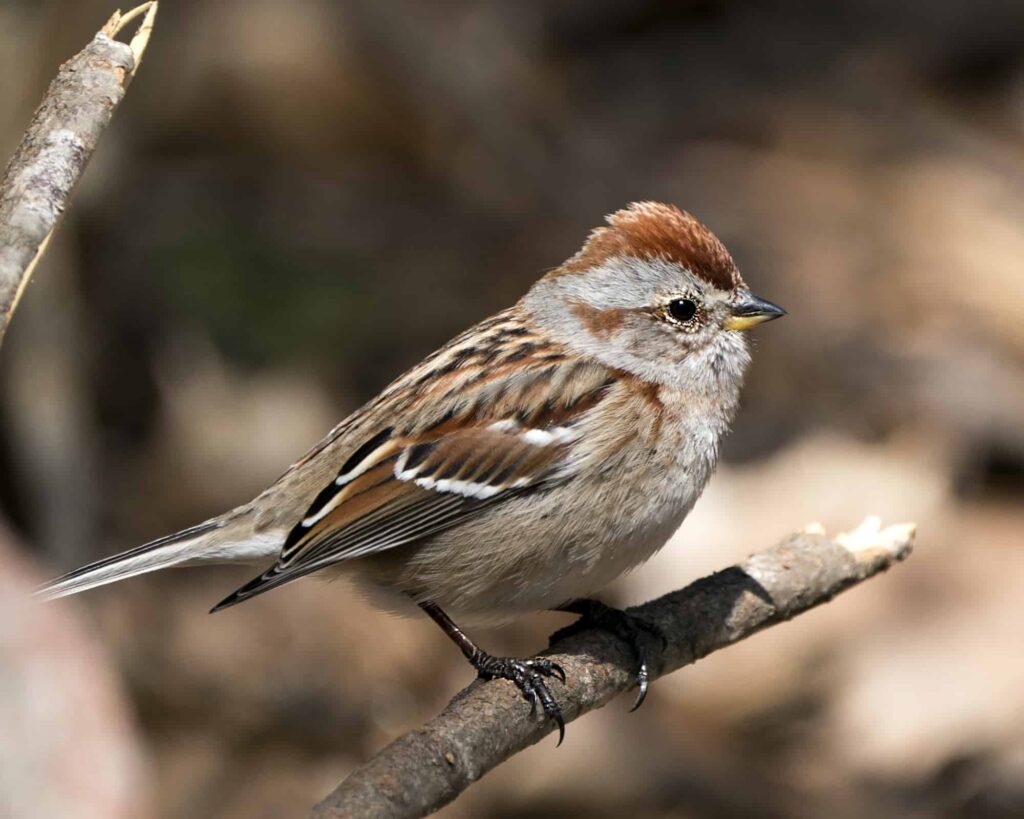New Hampshire offers so much natural beauty to its residents and visitors! From the 13 miles of seacoast in the south to the White Mountains and the Appalachian Mountains in the north, the Granite State is full of nature and wildlife.
That includes birds, of course!
There are 35 kinds of sparrows that live in North America, and 23 of them spend time in New Hampshire! These small songbirds are a delight at birdfeeders, in the trees, and all over the state.
What Makes a Sparrow a Sparrow?
According to the Spruce, “sparrow” the term applied to “a wide range of relatively small, mostly drab brown birds, which birders often call “LBJs” or “little brown jobs” because they can be notoriously difficult to identify.
While many of these birds include the word “sparrow” in their common names, other types of sparrows include buntings, towhees, and juncos.
Sparrows are all Passerines (songbirds). Their shared characteristics include:
- Small size, between 4-8 inches.
- Mostly brown plumage, which is great for camouflage.
- A short, stocky, cone-shaped bill.
How Many Sparrows Are in New Hampshire?
There are 23 different sparrows who spend time in New Hampshire. A few only travel through while they migrate between their breeding and winter territories. Most are here year-round or here for either the summer or winter.
There are sparrows who live exclusively along the Seacoast, and others who live mostly in the mountains.
Wherever you are in New Hampshire, though, you will have plenty of chances to see and hear sparrows.
Here’s what our list includes:
- Size (length, weight, and wingspan)
- Scientific name
- Description
- Interesting behaviors
- When and where they are in New Hampshire
Although identifying different kinds of sparrows can be a challenge for even the most experienced birder, we hope these descriptions and pictures can help you determine which bird is which!
We are dividing our list into sparrows that are present in New Hampshire in the summer, winter, only during migration, and all year.
Let’s dive in!
Year-round Sparrows in New Hampshire
The sparrows that live in New Hampshire year-round are: Dark-Eyed Junco, House Sparrow, Song Sparrow, and White-Throated Sparrow.
Dark-Eyed Junco
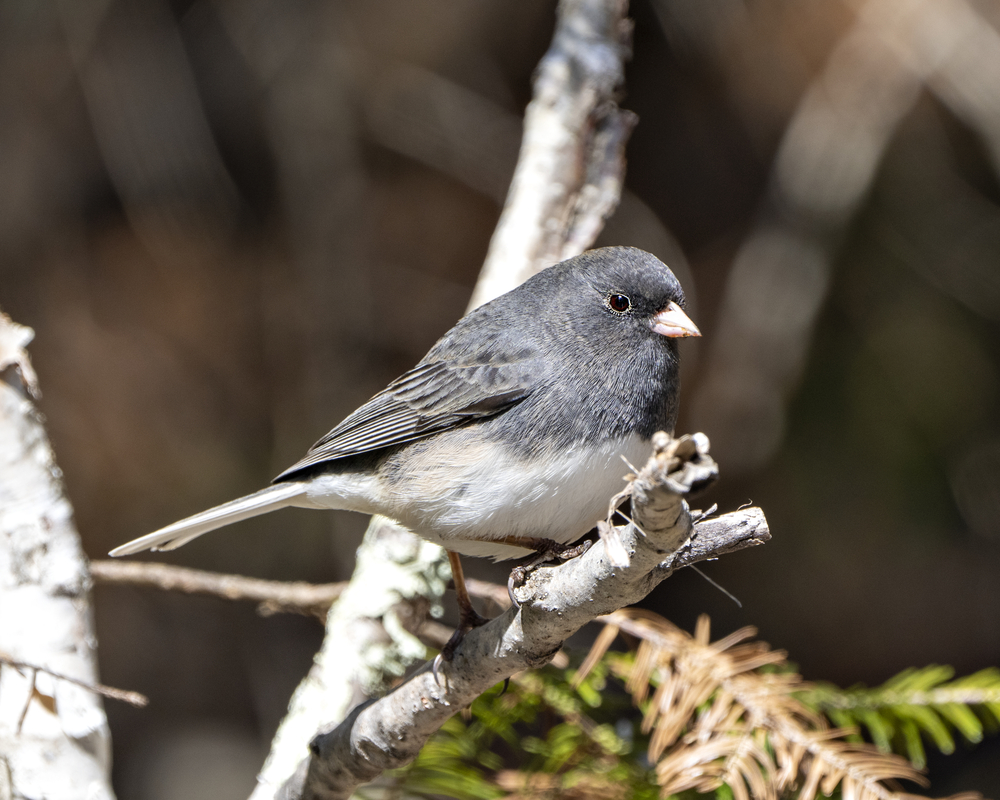
- Junco hyemalis
- ORDER: Passeriformes
- FAMILY: Passerellidae
- Length: 5.5-6.3 in (14-16 cm)
- Weight: 0.6-1.1 oz (18-30 g)
- Wingspan: 7.1-9.8 in (18-25 cm)
Dark-Eyed Juncos can look different from region to region. Generally, their coloring is dark gray or brown, and they have a pink bill. Their white outer tail feathers are visible in flight.
In New Hampshire, the Dark-Eyed Junco’s belly is white. While males are dark gray, females are more brown in color. They are also slightly smaller than the males.
They breed in coniferous and mixed-coniferous forests, and of course, there are plenty of those in New Hampshire! They are especially plentiful in the Appalachian Mountains. They can be spotted out in the open during the winter, in parks, fields, and backyards. They are common visitors to backyard feeders in the winter, too.
House Sparrow
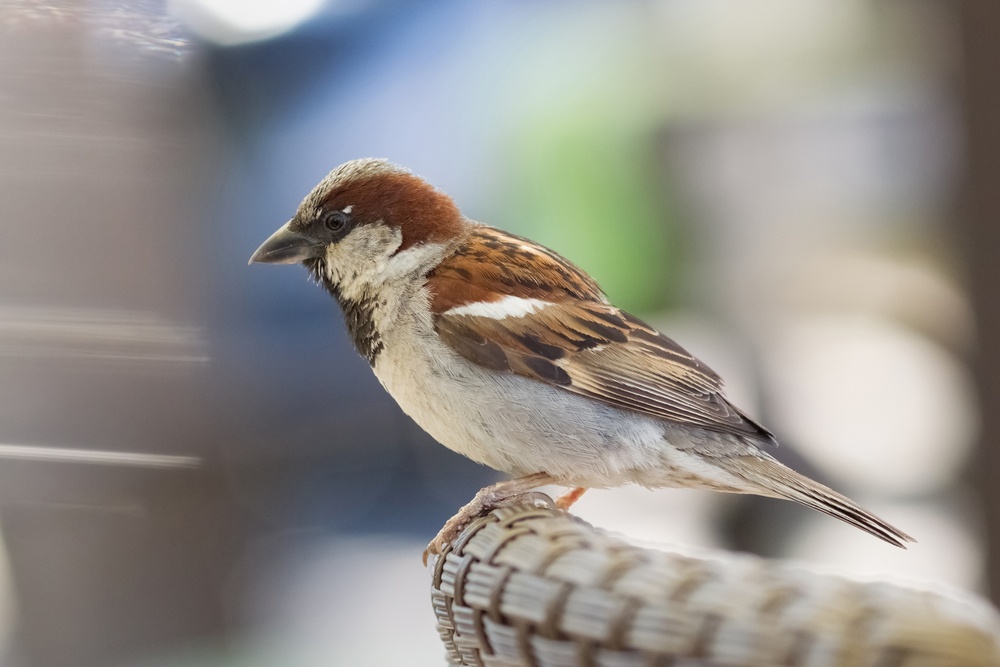
- Passer domesticus
- ORDER: Passeriformes
- FAMILY: Passeridae
- Length: 5.9-6.7 in (15-17 cm)
- Weight: 0.9-1.1 oz (27-30 g)
- Wingspan: 7.5-9.8 in (19-25 cm)
House Sparrows live where there are houses. They are one of the most common birds in North America, ranking alongside European Starlings and Rock Pigeons. Some naturalists dislike House Sparrows because of their uncanny ability to displace native species from bird feeders and boxes.
Males are multi-colored: gray heads, white cheeks, rufous necks, black bibs. Females are brown with a striped back.
They are year-round residents of New Hampshire — and just about every other state in the contiguous US.
House Sparrows prefer to nest in human-made structures, including the beams and rafters of houses and barns.
Song Sparrow

- Melospiza melodia
- ORDER: Passeriformes
- FAMILY: Passerellidae
- Length: 4.7-6.7 in (12-17 cm)
- Weight: 0.4-1.9 oz (12-53 g)
- Wingspan: 7.1-9.4 in (18-24 cm)
Song Sparrows have a lot of variation across the country. Their bodies are streaky and brown, and the streaks on their chest and flanks are thick and white. Their coloring can be light brown to reddish brown, and some have more streaks than others.
Song Sparrows use the same nesting area time and time again. When one bird abandons a nest, it’s common for another to take over the same nest the next year.
Their habitat includes marshes, fields, backyards, and along the edges of the forest. They are common bird feeder visitors.
In Northern New Hampshire, Song Sparrows are breeding residents but leave at the end of the summer. In the southern half of the state, they are year-round residents.
White-Throated Sparrow
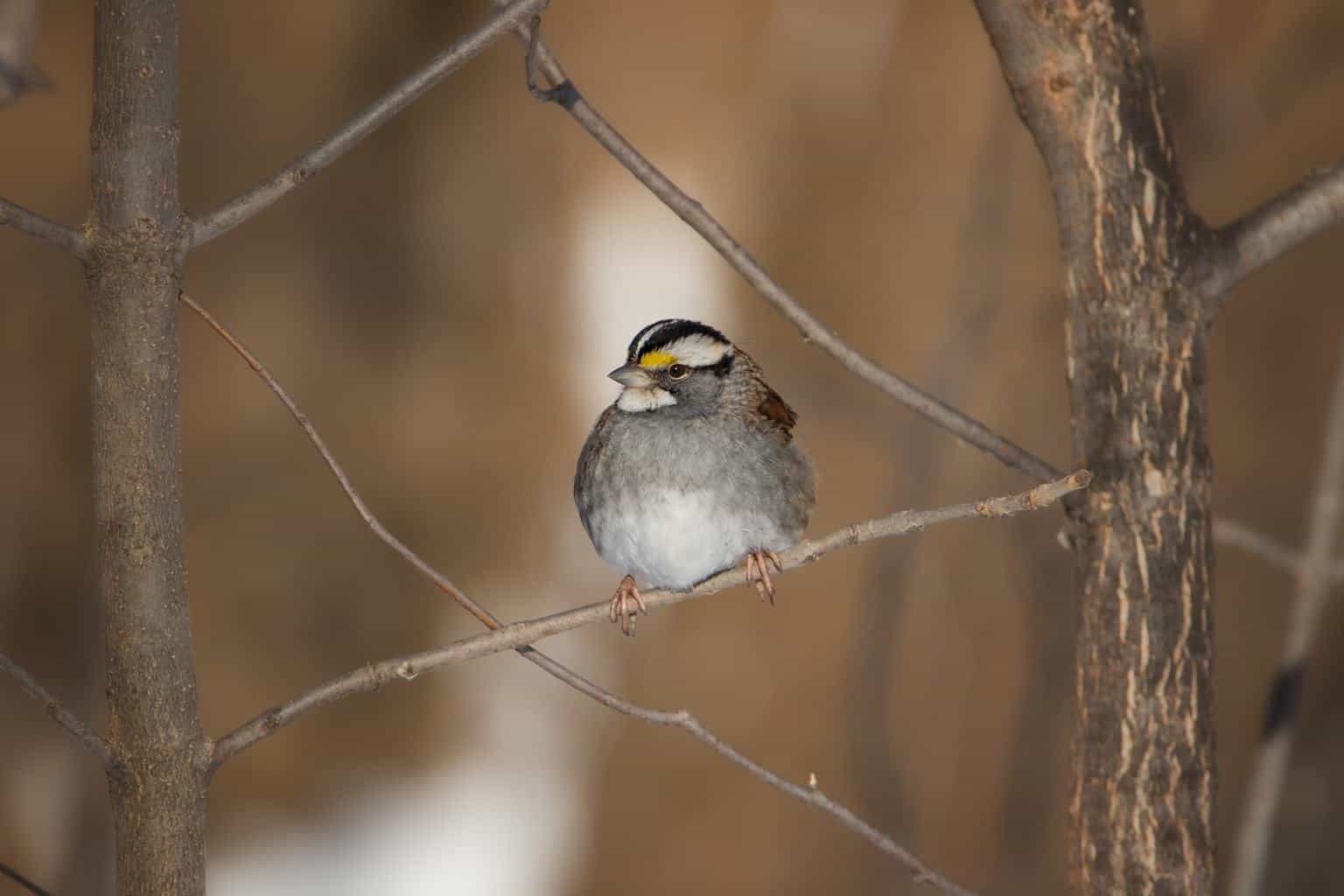
- Zonotrichia albicollis
- ORDER: Passeriformes
- FAMILY: Passerellidae
- Length: 6.3-7.1 in (16-18 cm)
- Weight: 0.8-1.1 oz (22-32 g)
- Wingspan: 7.9-9.1 in (20-23 cm)
There are two morphs of White-Throated Sparrows: those with white crowns and those with tan crowns. Typically, tan-crowned morphs mate with white-crowned morphs and white-crowned morphs tend to mate with tan-crowned morphs.
They are year-round residents of southern New Hampshire and breeding season residents of northern New Hampshire.
The White-Throated Sparrow has a black eyestripe, white crown, and yellow lores. Lores are the spaces on the sides of a bird’s head, between the eye and the bill.
White-Throated Sparrows look nothing like Dark-Eyed Juncos, but these two birds sometimes mate and create dull gray/white outer tail feathers.
Summer-only Sparrows in New Hampshire (Breeding Season Residents)
The 10 sparrows that live in New Hampshire in the summer are: Swamp Sparrow, Vesper Sparrow, Savannah Sparrow, Chipping Sparrow, Seaside Sparrow, Grasshopper Sparrow, Eastern Towhee, Nelson’s Sparrow, Saltmarsh Sparrow, and Field Sparrow.
Chipping Sparrow
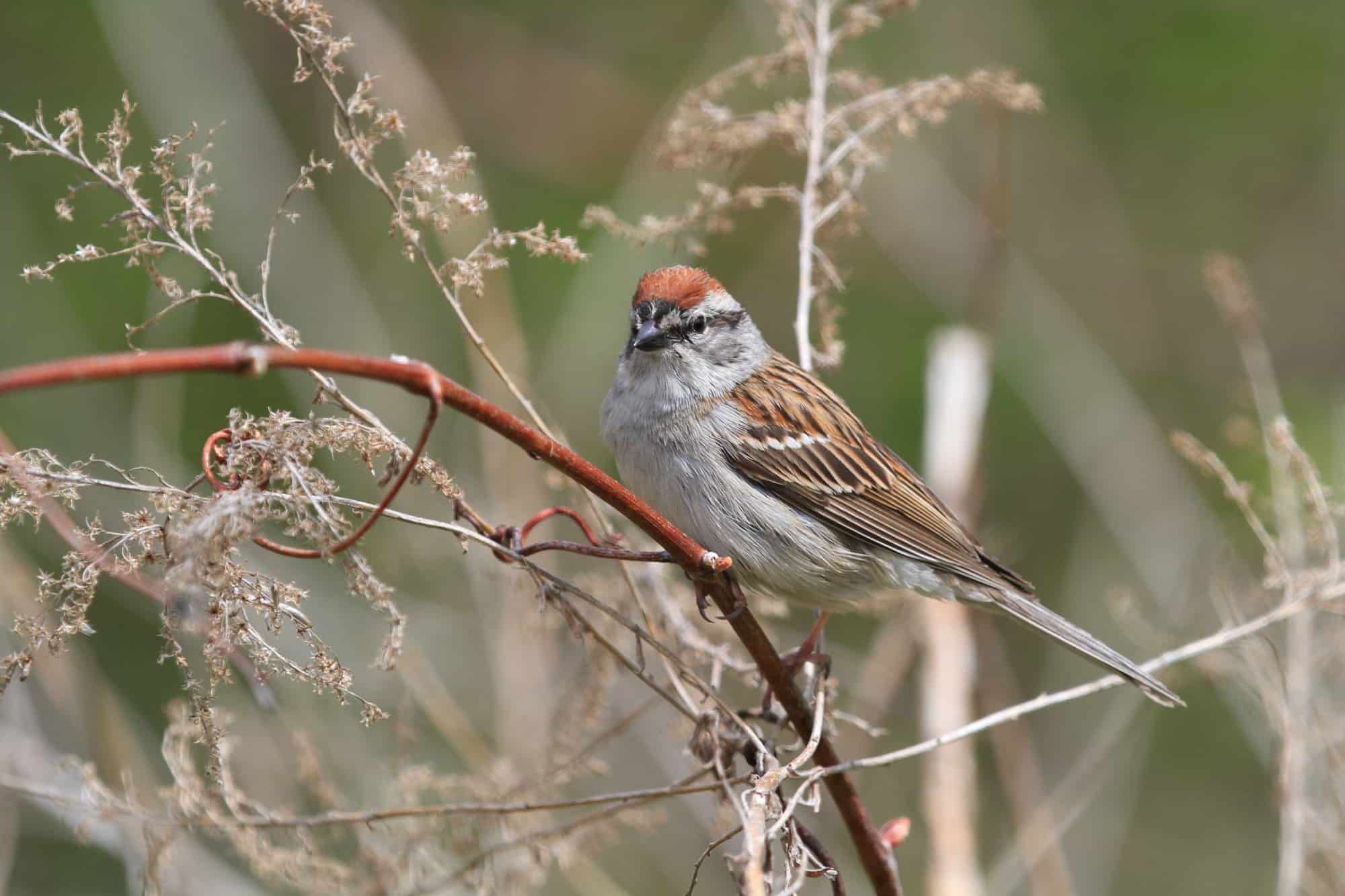
- Spizella passerina
- ORDER: Passeriformes
- FAMILY: Passerellidae
- Length: 4.7-5.9 in (12-15 cm)
- Weight: 0.4-0.6 oz (11-16 g)
- Wingspan: 8.3 in (21 cm)
Chipping Sparrows have a bright, rufous-brown cap that helps to differentiate them from other sparrows with similar brown and gray streaking.
They are incredibly common sparrows with a loud, trilling song.
They breed throughout almost all of North America. In the winter, their territory is almost entirely limited to Florida, southern California, coastal Mexico, and the Caribbean.
During the summer in New Hampshire, you will find (and hear!) Chipping Sparrows in both open woodlands and grassy clearings near the forest. They will visit birdfeeders in the summer, too.
Eastern Towhee

- Pipilo erythrophthalmus
- ORDER: Passeriformes
- FAMILY: Passerellidae
- Length: 6.8-8.2 in (17.3-20.8 cm)
- Weight: 1.1-1.8 oz (32-52 g)
- Wingspan: 7.9-11.0 in (20-28 cm)
The Eastern Towhee is the first sparrow on our list who looks very different from all of the others. The male’s head, back, and neck are dark black, and his sides are rufous. He has a white belly. The female’s pattern is the same, but where he is black, she is brown.
They are loud little birds whose call sounds like “chewink.” Their preferred habitat is in undergrowth, so you should watch for them in shrubby forests.
Eastern Towhees breed throughout most of the eastern US. They stay in the southeast year-round, but breeding Towhees leave the northeast for the winter. There are no consistent visitors to the White National Forest area of New Hampshire, but they breed throughout the Lakes Region, the Seacoast, Merrimack Valley, Dartmouth Lake-Sunapee, and Monadnock.
Field Sparrow
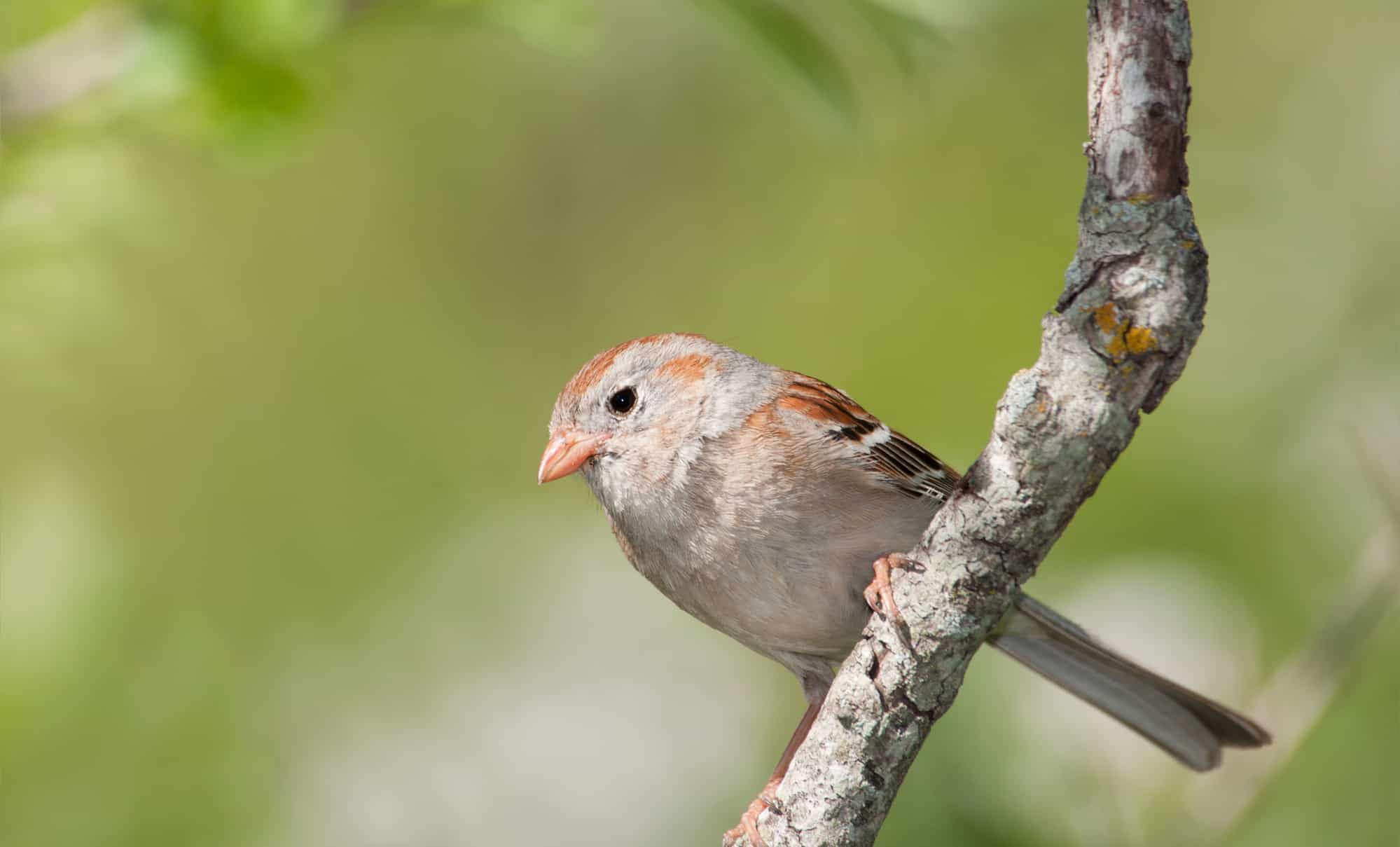
- Spizella pusilla
- ORDER: Passeriformes
- FAMILY: Passerellidae
- Length: 4.7-5.9 in (12-15 cm)
- Weight: 0.4-0.5 oz (11-15 g)
- Wingspan: 7.9 in (20 cm)
Field Sparrows have light gray colored bodies with some light and dark brown streaking on their backs and wings. They have a rusty-brown cap, a pink bill, and white eyering.
Field Sparrows avoid suburban areas with a lot of human activity. Instead, they prefer fields, prairies, and open land. Suburban expansion has caused a major impact on their population, which has been declining for the past fifty years.
They avoid nesting or visiting far northern New Hampshire, near the Canadian border, but they are common summer residents throughout the rest of the state.
Grasshopper Sparrow
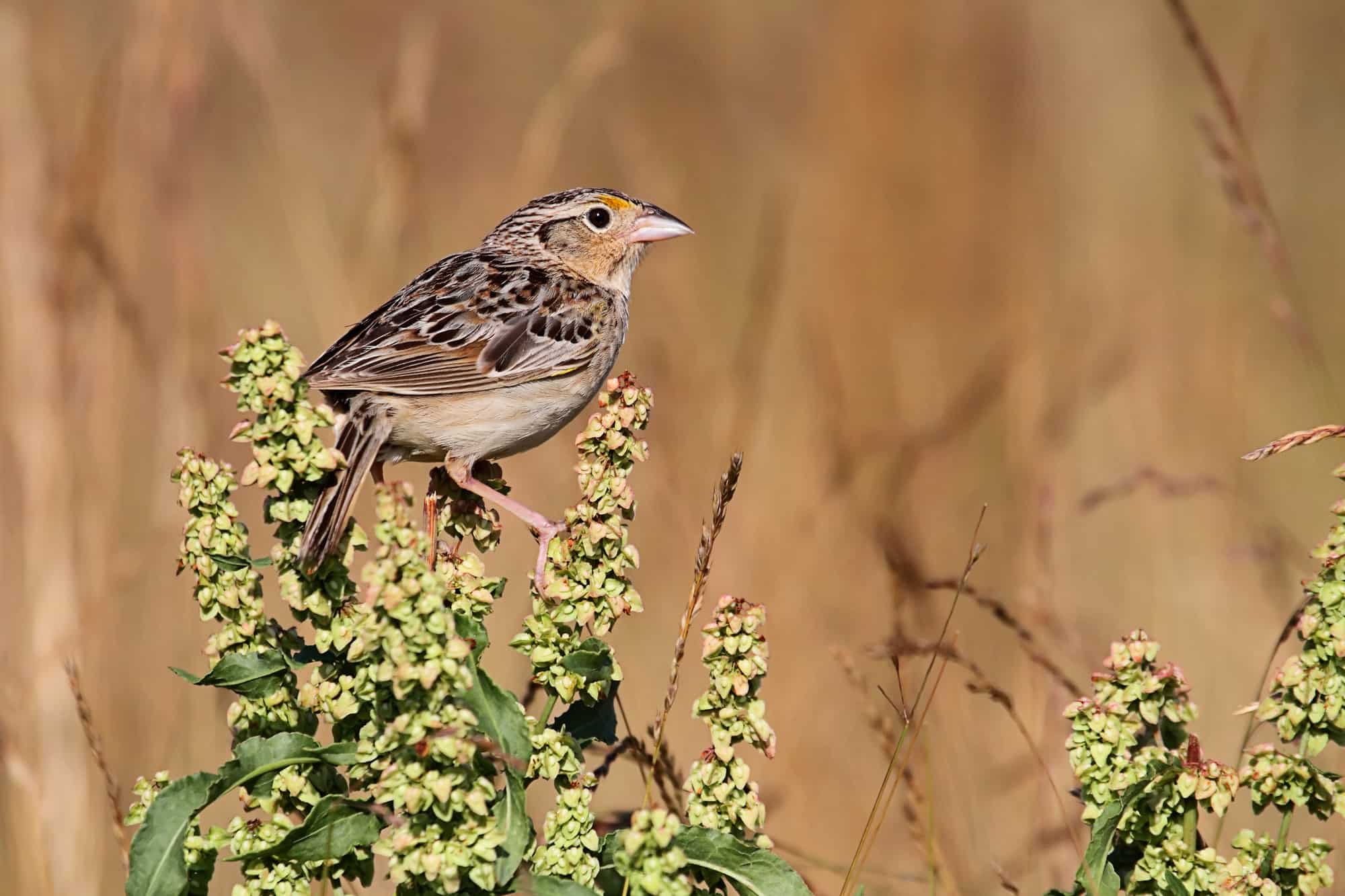
- Ammodramus savannarum
- ORDER: Passeriformes
- FAMILY: Passerellidae
- Length: 4.3-4.5 in (10.8-11.5 cm)
- Weight: 0.5-0.7 oz (14-20 g)
- Wingspan: 7.9 in (20 cm)
Grasshopper Sparrows have stubby tails and thick necks. Their coloring is less dramatic and contrasting than other sparrows — mostly light brown, gray, and orange. They also have a flat head and an oversized bill.
Grasshopper Sparrows sing two different songs, which is rare for North American sparrows. They get their name from their buzzy, insect-sounding song, but males will also produce a squeaky, musical song while they are flying.
These are yet another sparrow that will breed in southern New Hampshire but avoid the northern White Mountains and Great North Woods.
Nelson’s Sparrow
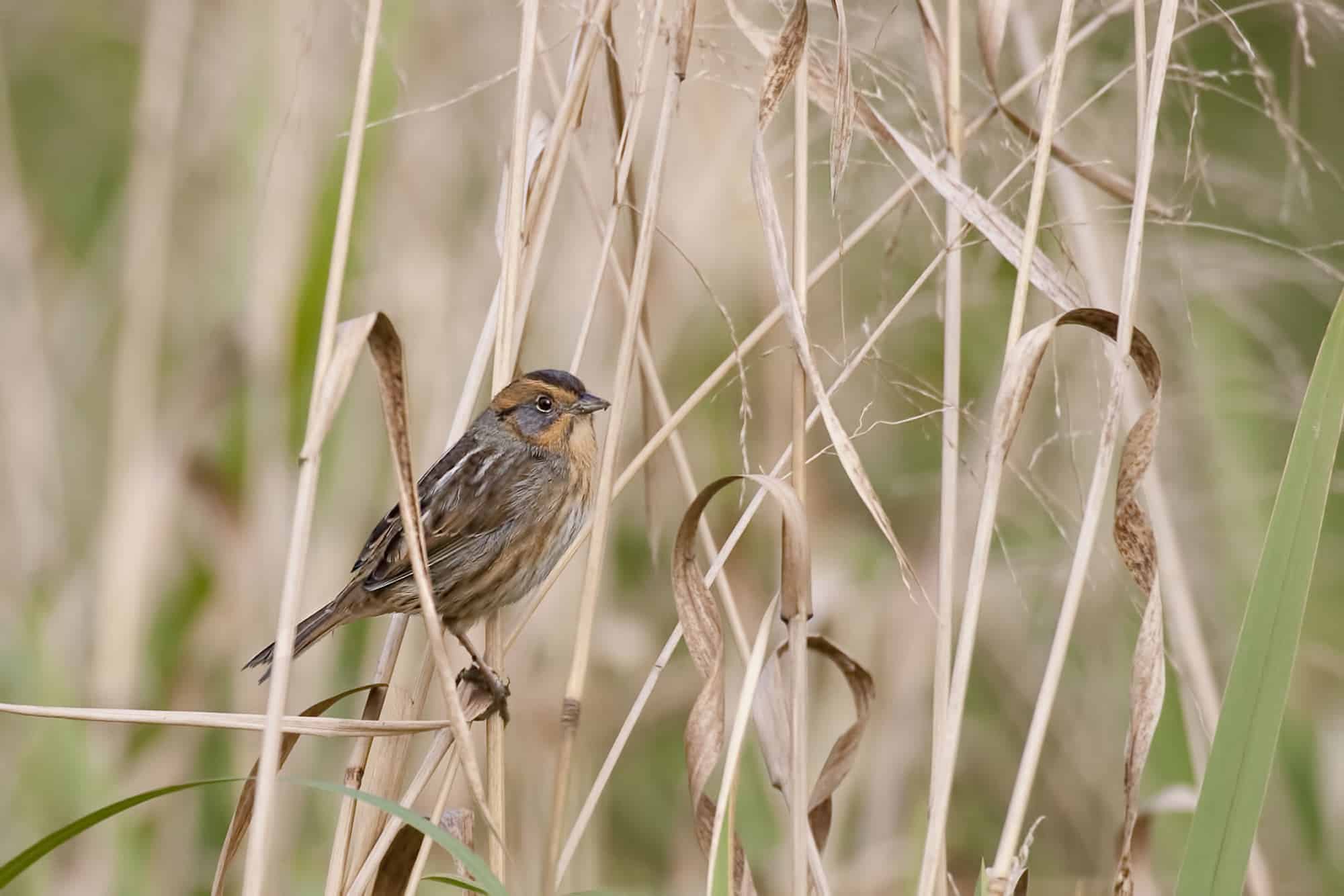
- Ammospiza nelsoni
- ORDER: Passeriformes
- FAMILY: Passerellidae
- Length: 4.3-5.1 in (11-13 cm)
- Weight: 0.6-0.7 oz (17-21 g)
- Wingspan: 6.5-7.9 in (16.5-20 cm)
The Nelson’s Sparrow is light yellow, making it more colorful than many other sparrows. However, on the Atlantic Coast, their coloring is much more muted. Instead, they are mostly gray and very pale yellow, with some light streaking on their breast.
Nelson’s Sparrows and Saltmarsh Sparrows used to be considered the same species, but they were classified as different species in 1998. The original shared name for these two birds was the Sharp-Tailed Sparrow.
In New Hampshire, you will only find Nelson’s Sparrows along the Seacoast in the summer. After that, they migrate to the Atlantic and Gulf Coasts, where they spend the winter along the saltmarshes.
Saltmarsh Sparrow
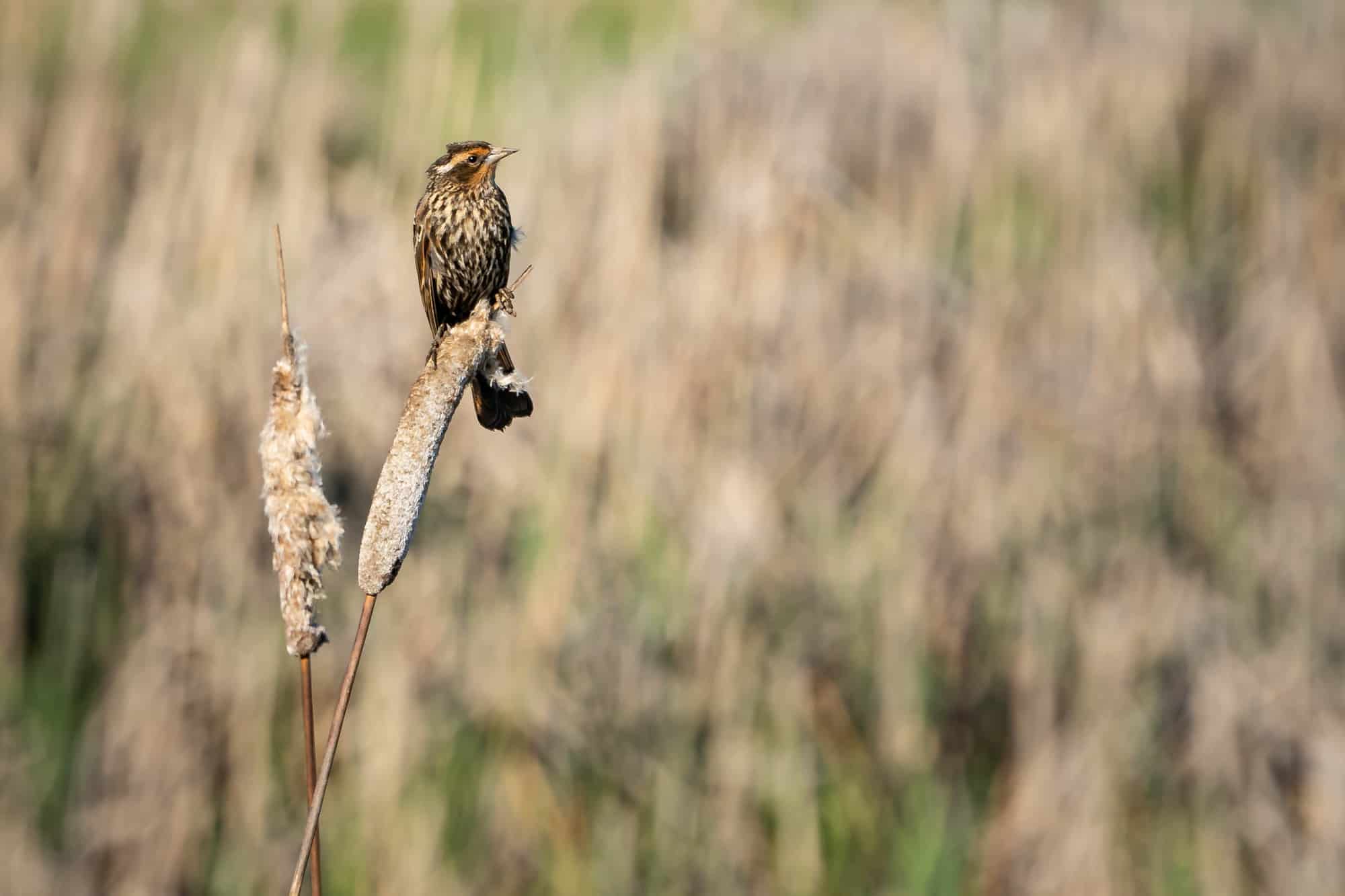
- Ammospiza caudacuta
- ORDER: Passeriformes
- FAMILY: Passerellidae
- Length: 4.7-5.1 in (12-13 cm)
- Weight: 0.6-0.8 oz (17.1-24.1 g)
- Wingspan: 6.5-7.7 in (16.5-19.5 cm)
The Saltmarsh Sparrow has an even smaller range than its close relative, the Nelson’s Sparrow.
They are dark gray on top and light brownish-cream on their chests and bellies. There is some slight yellow to their coloring. They have white stripes on their backs, and their face is orangey brown.
These little sparrows are difficult to find, as they prefer to hide in marshy vegetation. They live very close to the coastline. In New Hampshire, they are found only in the summer, where they nest on the ground in protected marshy grasses and shrubs.
They nest so close to the water that sometimes, the high tides will briefly fill their nests with water.
Slightly south of New Hampshire, the Saltmarsh Sparrow lives year-round. Some will also migrate to the southern Atlantic and Gulf Coasts of the US.
Savannah Sparrow
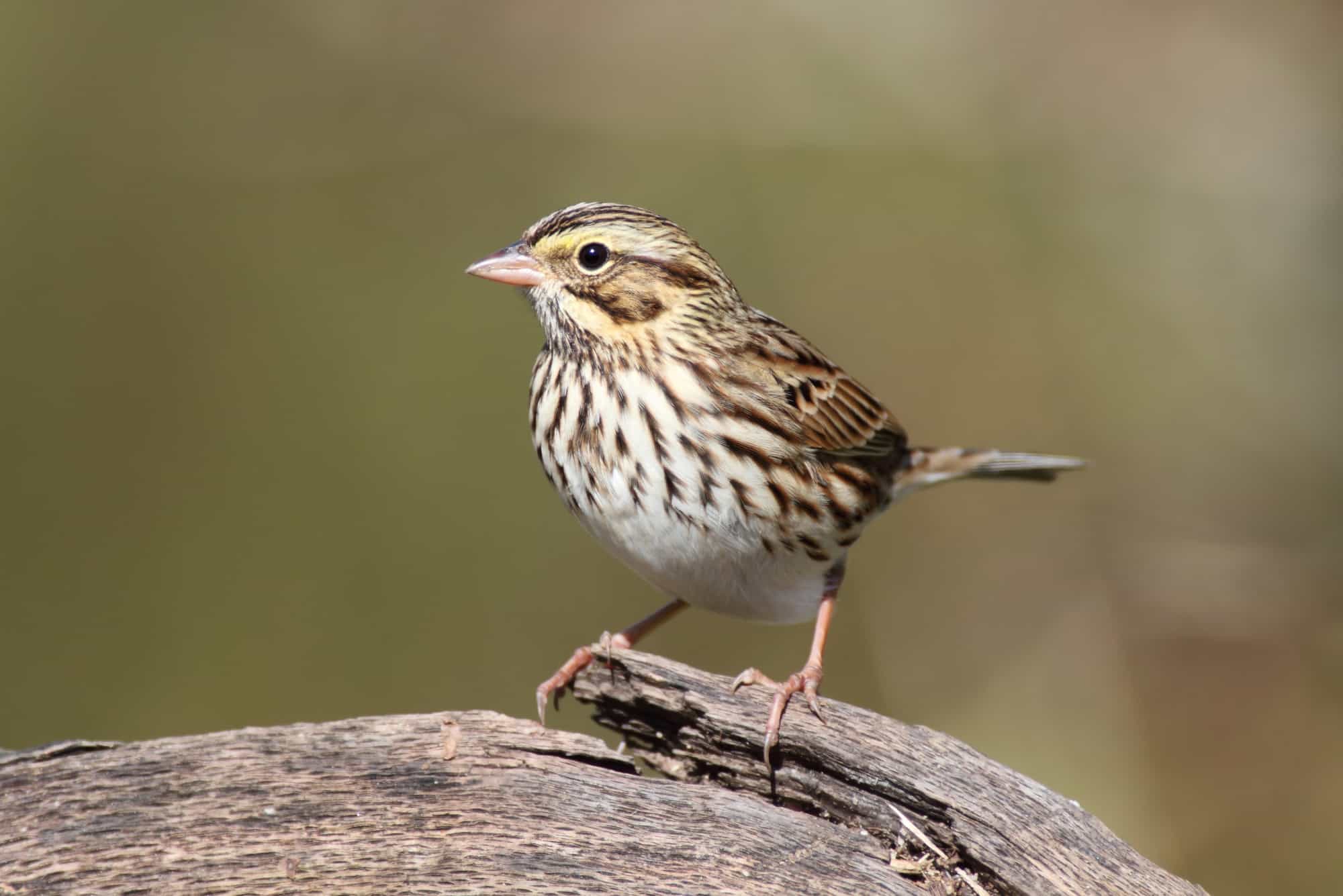
- Passerculus sandwichensis
- ORDER: Passeriformes
- FAMILY: Passerellidae
- Length: 4.3-5.9 in (11-15 cm)
- Weight: 0.5-1.0 oz (15-28 g)
- Wingspan: 7.9-8.7 in (20-22 cm)
Savannah Sparrows are somewhat easier to identify than other streaky brown sparrows, thanks to the yellow spot between its eyes and sharp bill. In addition to being easier to recognize, they are also more likely to draw attention to themselves by singing a loud, buzzy, insect-like sound, even out in the open.
They are small-headed and have a small brown crown. Their streaking is light brown, dark brown, white, and yellow.
They are incredibly common songbirds in North America. Their breeding territory includes almost all of Canada and the top half of the US. In New Hampshire, you can find them throughout the entire state during the summer, including the less-frequently visited White Mountains and Great North Woods.
Seaside Sparrow
- Ammospiza maritima
- ORDER: Passeriformes
- FAMILY: Passerellidae
- Length: 5.1-5.9 in (13-15 cm)
- Weight: 0.7-1.0 oz (19-29 g)
- Wingspan: 7.1-7.9 in (18-20 cm)
There is a lot of variation between subspecies of the Seaside Sparrow, but they all have the following in common: large for a sparrow, long pointed bill, rounded tail, rounded wings, and long, strong legs.
Their coloring is typically dark gray on top and a streaky pale chest and belly. There is a yellow spot in front of the Seaside Sparrow’s eye, and they have an off-white throat. Some are much darker in color than others.
They rarely depart from the salt marshes where they have lots of protection from predators and the elements. They forage in mud for invertebrates and nest among the marsh grasses.
Although the Seaside Sparrow does not nest along the coast of Maine or Massachusetts, it does have nesting territory along the Seacoast of New Hampshire!
Swamp Sparrow
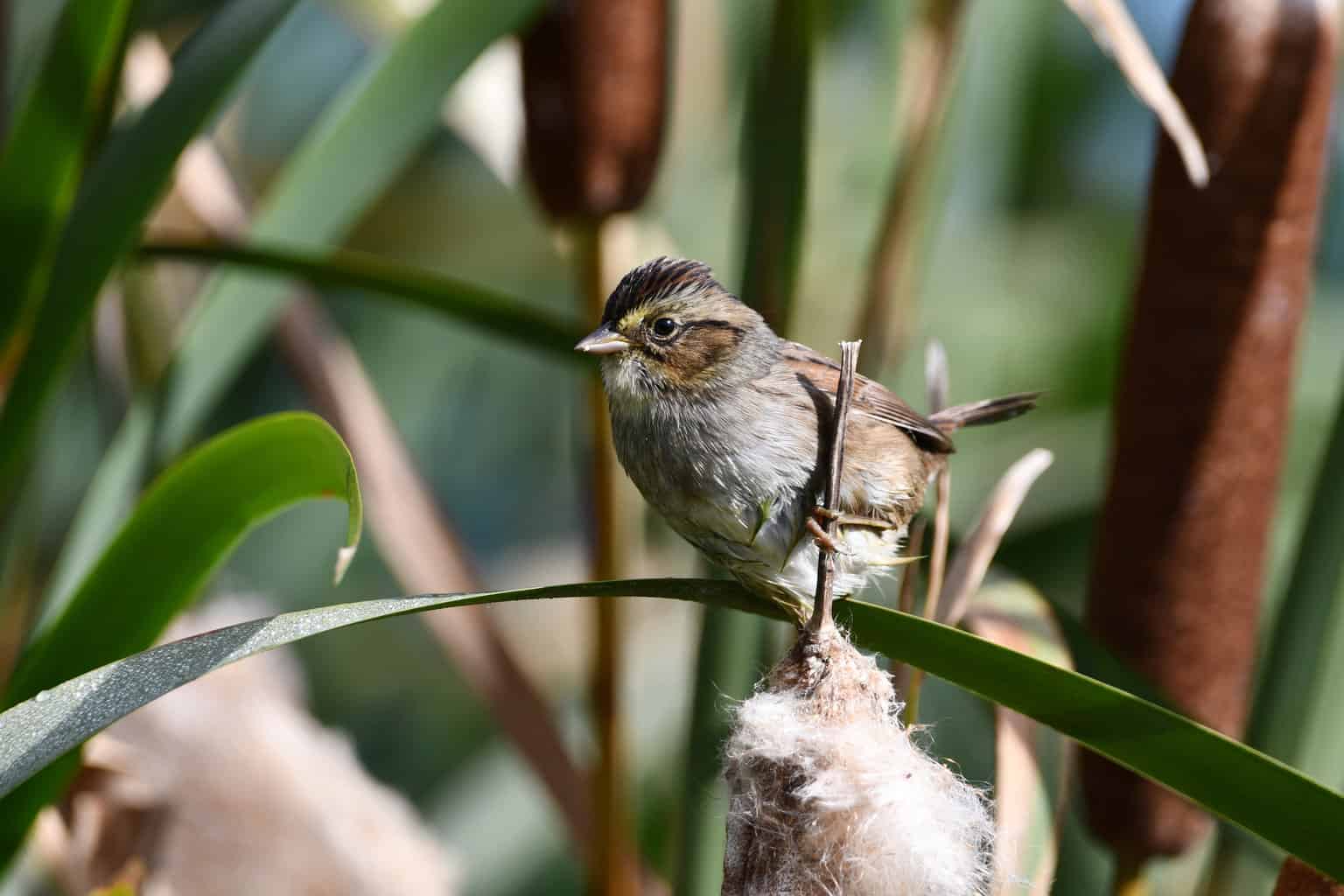
- Melospiza georgiana
- ORDER: Passeriformes
- FAMILY: Passerellidae
- Length: 4.7-5.9 in (12-15 cm)
- Weight: 0.5-0.8 oz (15-23 g)
- Wingspan: 7.1-7.5 in (18-19 cm)
The Swamp Sparrow is has a rounded body and a long-ish tail. Its silhouette is comparable to the Song Sparrow, which is more widespread in North America.
Their coloring is relatively dark, with a rust-brown crown and wings. The rest of the bird is gray and white.
Swamp Sparrows rarely leave their wetland habitats. They prefer staying in dense underbrush. Like other marsh-dwelling sparrows, they have long, strong legs. This is what helps them to forage in the mud and in aquatic grasses along the shoreline.
New Hampshire is the southern range of the Swamp Sparrow’s breeding range. Just south of New Hampshire, they are year-round residents in Massachusetts.
Vesper Sparrow
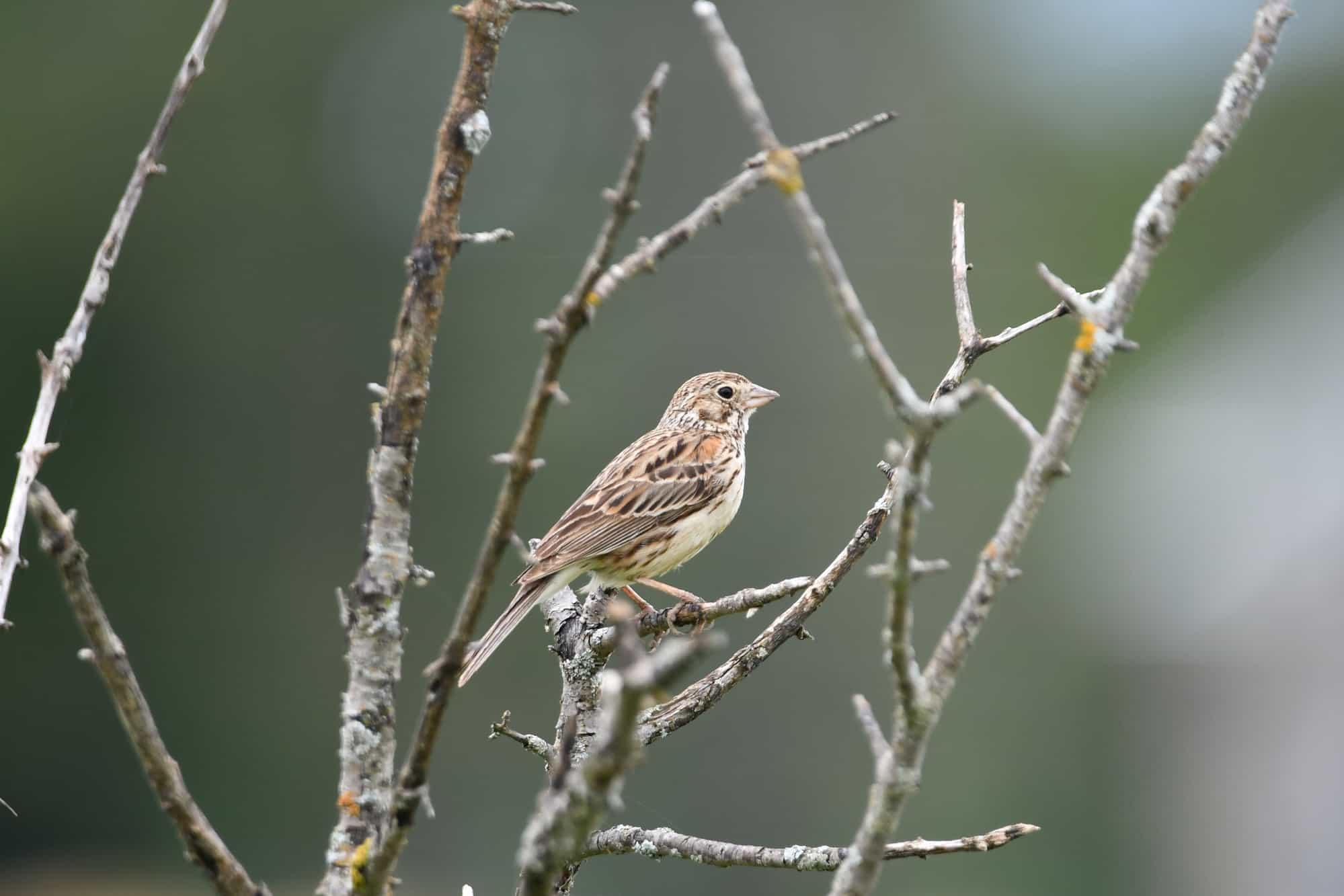
- Pooecetes gramineus
- ORDER: Passeriformes
- FAMILY: Passerellidae
- Length: 5.1-6.3 in (13-16 cm)
- Weight: 0.7-1.0 oz (20-28 g)
- Wingspan: 9.4 in (24 cm)
Vesper Sparrows are one of the larger North American sparrows. They are streaky brown with white eyerings. They have a chestnut brown patch on their shoulders, but it can be difficult to see. In flight, you’ll see white tail feathers.
The Vesper Sparrow gets its name from the lovely, musical song it sings at twilight.
They are primarily found on the ground, in tall grass. Males fly up to a perch to sing, though.
Vesper Sparrows are widespread throughout North America. Interestingly, these sparrows breed in southern New Hampshire and in far northern New Hampshire, but not in the White Mountains.
Winter-season Sparrows in New Hampshire
There are only three kinds of sparrows that live in New Hampshire exclusively in the winter: the American Tree Sparrow, the Horned Lark, and the Snow Bunting.
American Tree Sparrow
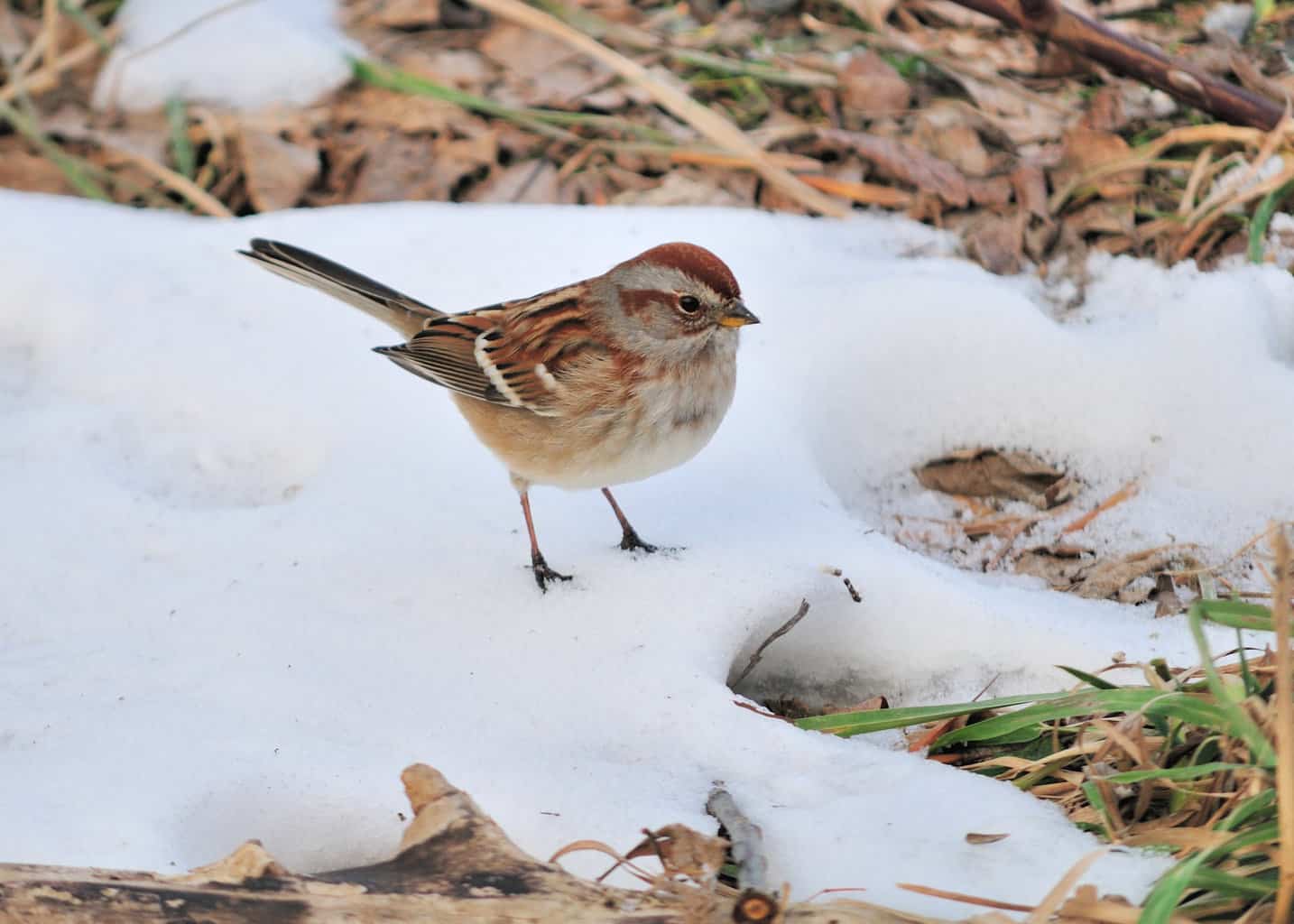
- Spizelloides arborea
- ORDER: Passeriformes
- FAMILY: Passerellidae
- Length: 5.5 in (14 cm)
- Weight: 0.5-1.0 oz (13-28 g)
- Wingspan: 9.4 in (24 cm)
American Tree Sparrows are gray-bodied with a dark, reddish-brown crown and striped wings. Many of them have a red patch on their breast.
Their breeding territory is far to the north, stretching across the Canadian tundra. They migrate through southern Canada and end up spending the winter in the northern half of the US, including New Hampshire.
They are found in the state’s snowy fields. Their diet consists mostly of seeds, and they gather in small flocks to scratch the ground for seeds. They are sometimes spotted on top of shrubs and goldenrod plants.
Horned Lark
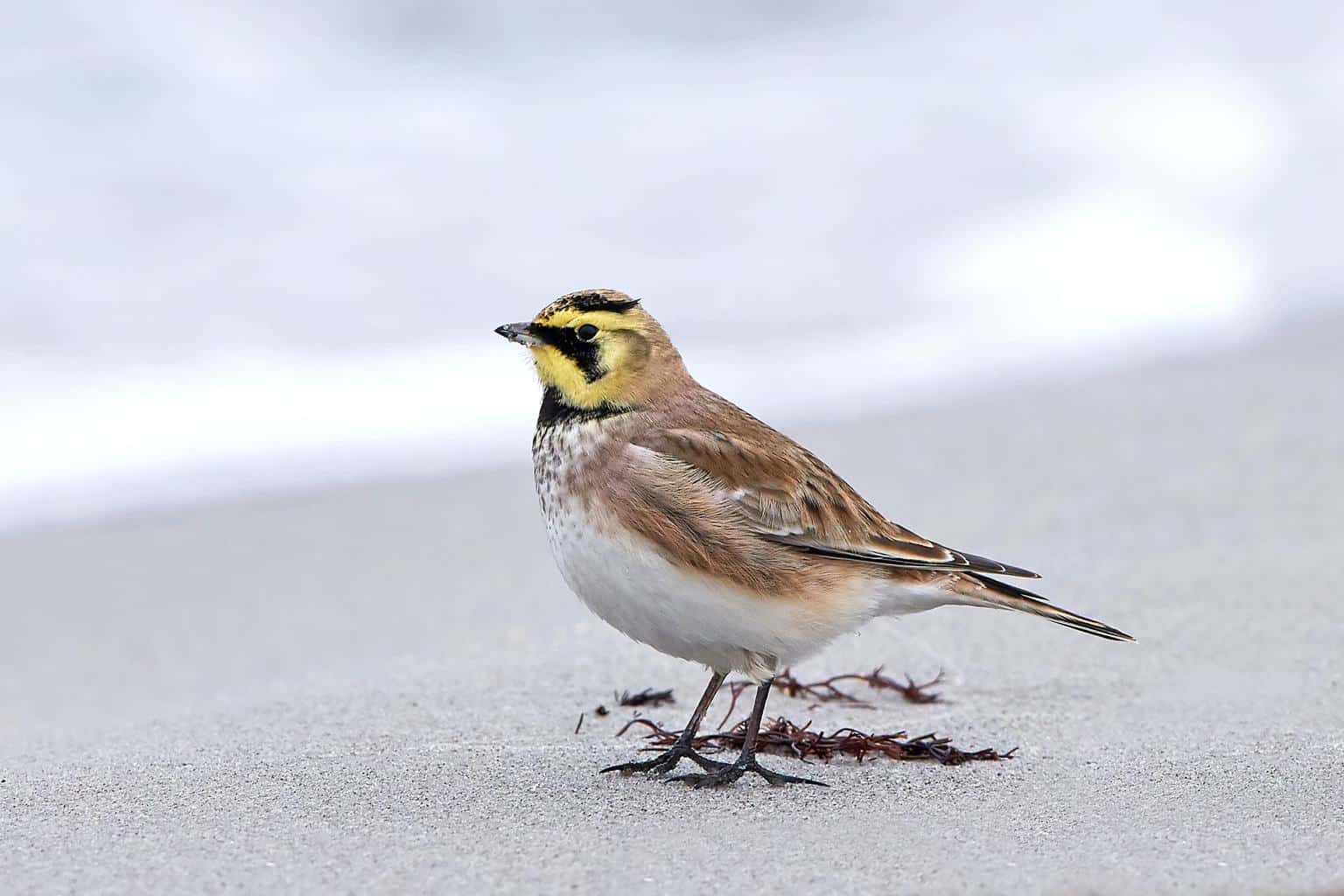
- Eremophila alpestris
- ORDER: Passeriformes
- FAMILY: Alaudidae
- Length: 6.3-7.9 in (16-20 cm)
- Weight: 1.0-1.7 oz (28-48 g)
- Wingspan: 11.8-13.4 in (30-34 cm)
Female Horned Larks are gray with a black band across the breast and light brown streaking on their backs. Males have a yellow face, a dark black breast band and eye mask, and two distinctive “horns” on the sides of their heads.
Females collect small rocks, corncobs, and even balls of dung to “pave” the area around their nests. This is a mysterious behavior that researchers can’t yet explain.
In most of New Hampshire, Horned Larks are only here in the winter. However, a small number of them will stay along the Seacoast region year-round.
Snow Bunting
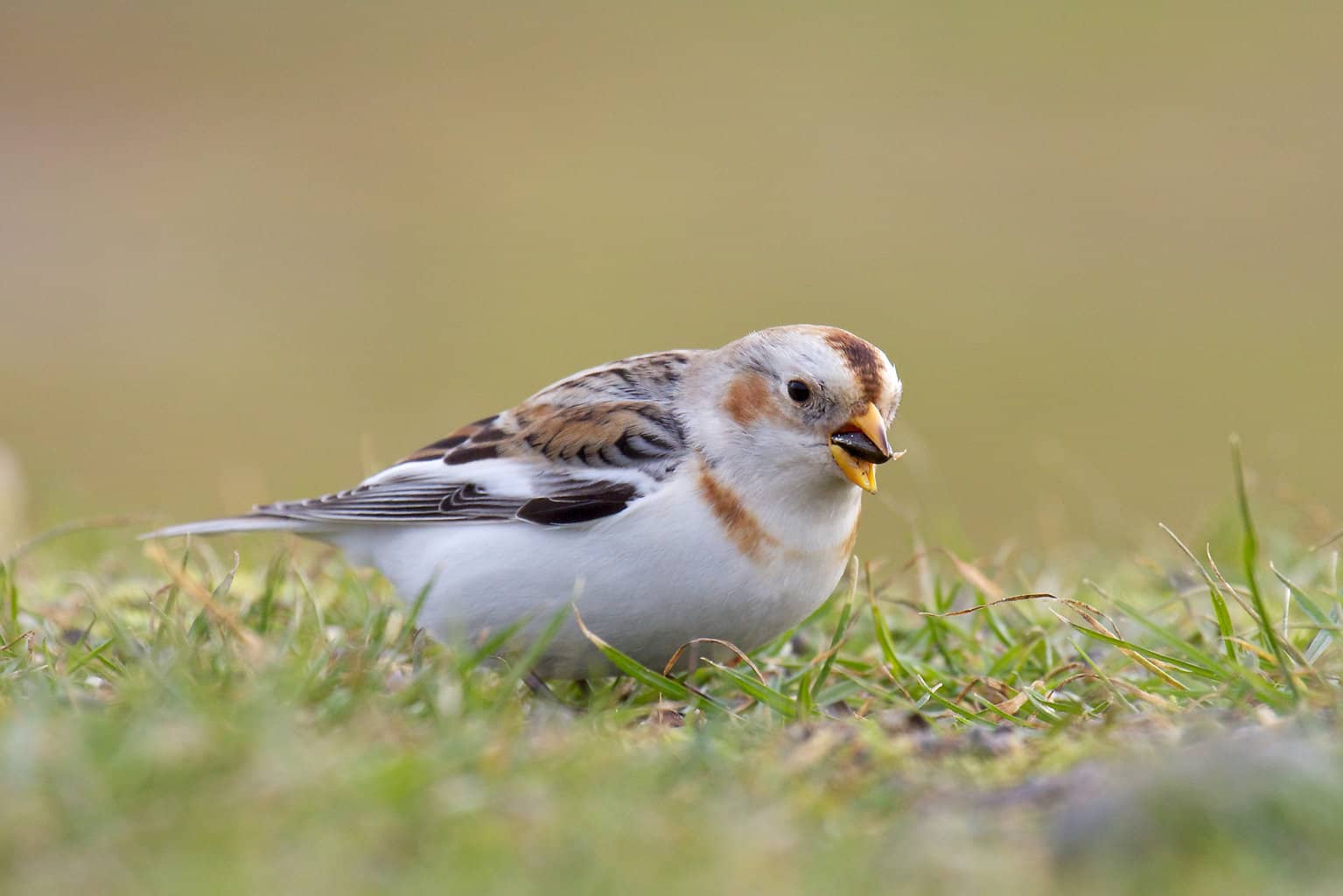
- Plectrophenax nivalis
- ORDER: Passeriformes
- FAMILY: Calcariidae
- Length: 5.9 in (15 cm)
- Weight: 1.1-1.6 oz (31-46 g)
- Wingspan: 11.8 in (30 cm)
There is no mistaking the Snow Bunting for any other member of the Passeriform order. There is variation in their coloring, but all of them have black-tipped wings with white inner wings. During the breeding season, females are off-white, and their head is streaked in black. During the winter, the females’ head is lightly rusty with some dark patches.
Breeding season males, on the other hand, are mostly bright white with a black back. During the winter, they are white underneath and have a rusty brown crown. Their back is covered in dark streaks.
Snow Buntings live far to the north during the breeding season, across the Canadian tundra. They live throughout New Hampshire, all winter long. They are comfortable with the state’s coldest temperatures, considering their breeding grounds are frequently well below 0° F.
Migratory Sparrows in New Hampshire
Five kinds of sparrows migrate through New Hampshire but don’t breed in the state or stay here for the winter: the American Pipit, the Dickcissel, the Fox Sparrow, the Lapland Longspur, and the White-Crowned Sparrow.
American Pipit
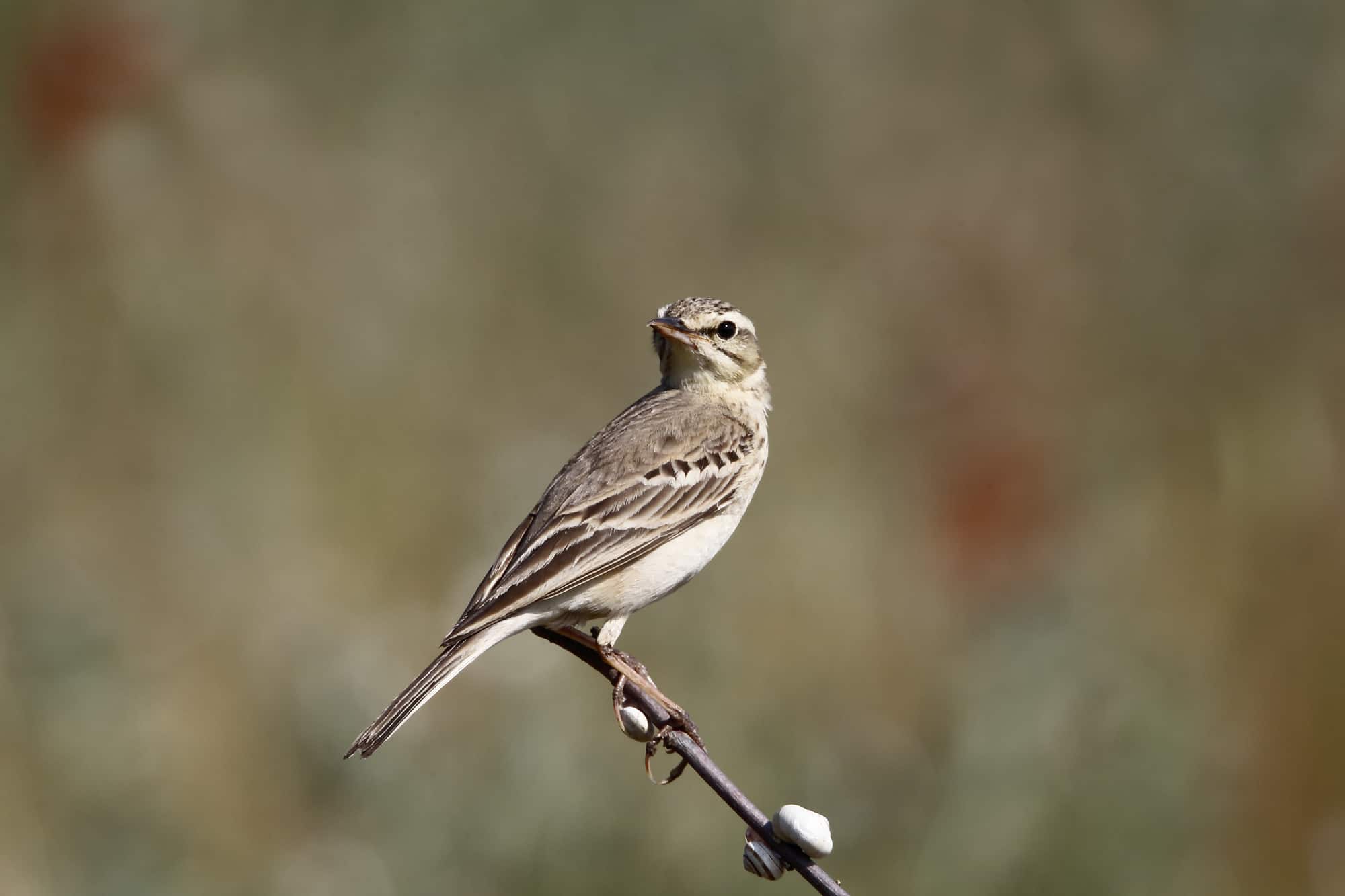
- Anthus rubescens
- ORDER: Passeriformes
- FAMILY: Motacillidae
- Length: 5.5-6.7 in (14-17 cm)
- Weight: 0.7-0.9 oz (19-26 g)
- Wingspan: 10.6 in (27 cm)
The American Pipit is muted in pale gray and brown. During the winter, the streaks on their sides and breast become more dramatic and noticeable.
American Pipits have a hallux with a toenail. This is a long hind toe, which gives them additional stability as they walk and forage on snowy grounds. They sometimes behave like shoreline foragers.
They are inconspicuous little birds who spend the summer on the tundra and the winter in alpine meadows. They are not commonly spotted in New Hampshire, but they will occasionally stop here on their migration to the south and southwest US and Mexico.
American Pipits also winter in Russia. Pipits that breed in Russia migrate to eastern China and the East Asian islands during the winter.
Dickcissel
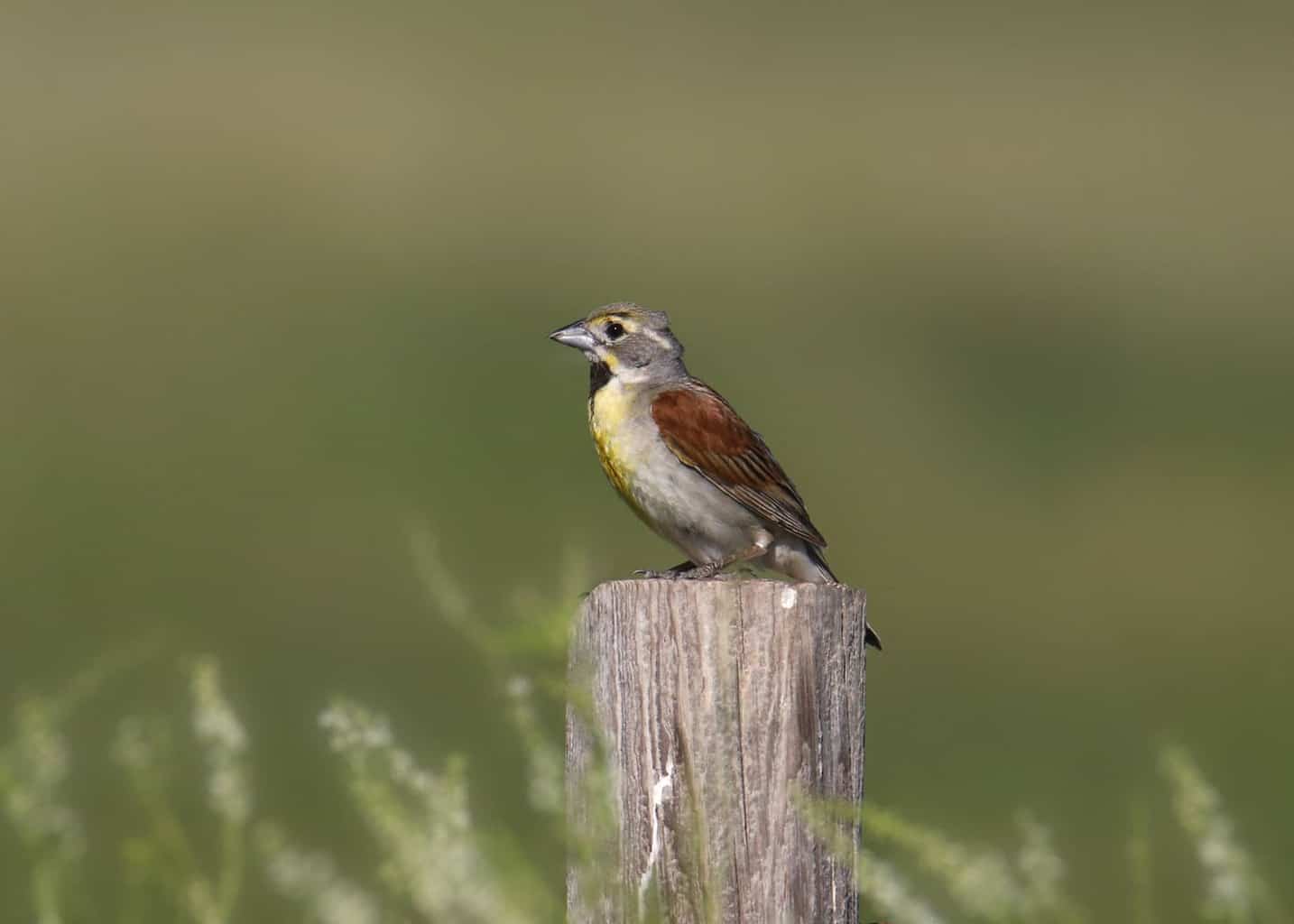
- Spiza americana
- ORDER: Passeriformes
- FAMILY: Cardinalidae
- Length: 5.5-6.3 in (14-16 cm)
- Weight: 0.9-1.4 oz (25.6-38.4 g)
- Wingspan: 9.8-10.2 in (24.8-26 cm)
Male Dickcissels have bright yellow coloring on their faces. He has a black, v-shaped chest band and a yellow breast. His wings vary from light to dark brown.
Females look similar to males, but their coloring is more muted, and they do not have a black chest band. Both sexes have a yellow stripe above their eye, like an eyebrow.
The Dickcissel’s song sounds just like its name. They migrate in massive flocks and may stop in New Hampshire on their migration. More frequently, they are migratory visitors along the Mid-Atlantic Coast.
The Fox Sparrow

- Passerella iliaca
- ORDER: Passeriformes
- FAMILY: Passerellidae
- Length: 5.9-7.5 in (15-19 cm)
- Weight: 0.9-1.6 oz (26-44 g)
- Wingspan: 10.5-11.4 in (26.7-29 cm)
There are significant differences between Fox Sparrows from region to region. However, they are usually brownish-red and gray, with thick brown spotting on their chest.
Fox Sparrows are known for kicking leaves and dirt around as they forage.
They are widespread around the globe, as individual vagrants have been spotted in places like Greenland, Iceland, Italy, Germany, and Ireland. It’s possible that some of them arrived in these places by traveling on ships.
They are frequent migratory visitors in New Hampshire, although some individuals may also spend the winter along the Seacoast.
Lapland Longspur
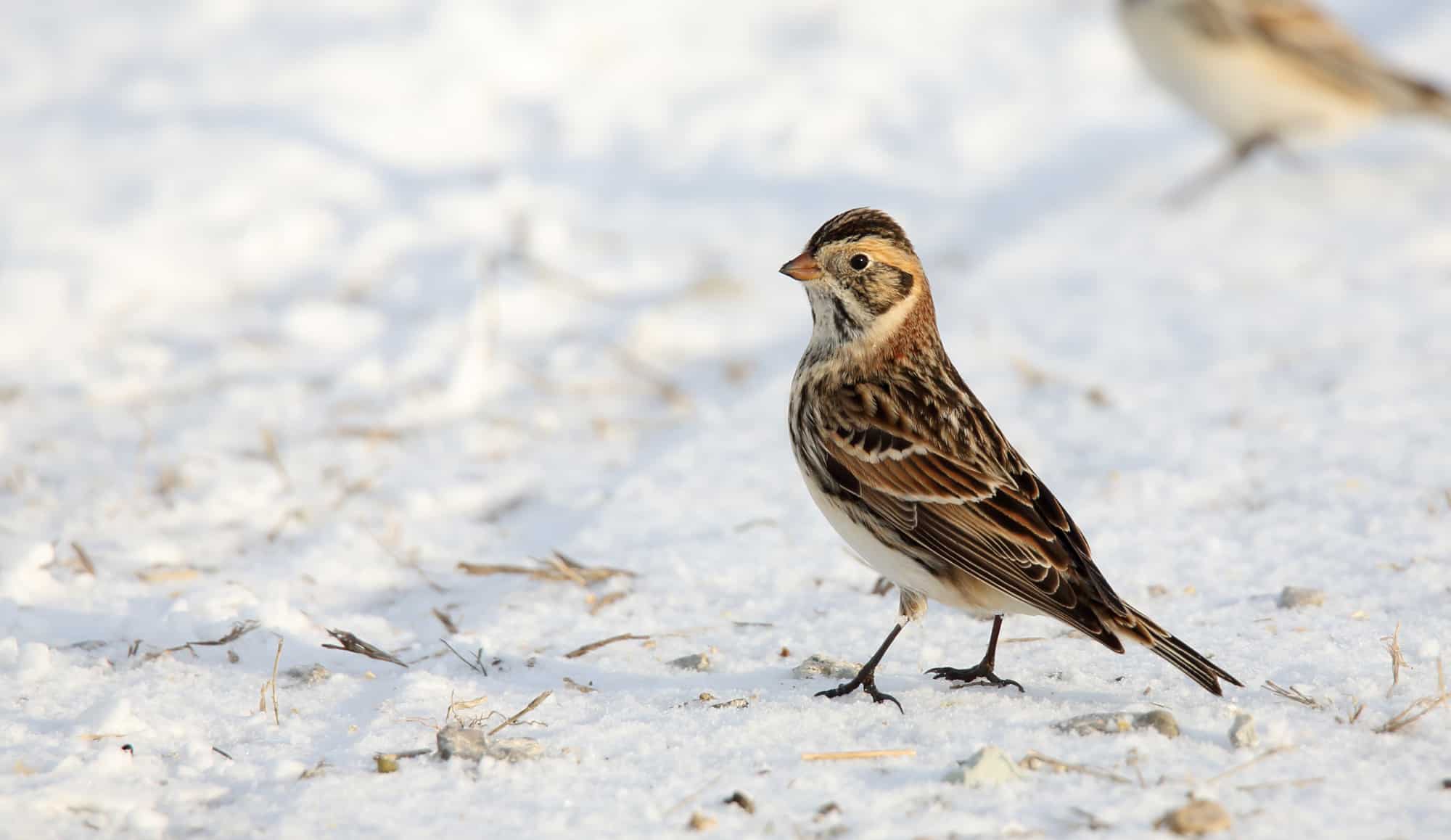
- Calcarius lapponicus
- ORDER: Passeriformes
- FAMILY: Calcariidae
- Length: 5.9-6.3 in (15-16 cm)
- Weight: 0.8-1.2 oz (22.3-33.1 g)
- Wingspan: 8.7-11.4 in (22-29 cm)
Lapland Longspurs are bigger than most other sparrows. During the breeding season, males have a black face that has a yellowish-white border. They also have a brown patch on the back of their neck. Females don’t have as much black, but both sexes have dark brown and black streaking on their wings.
During the winter, both sexes become paler, and their streaking becomes less dramatic.
Lapland Longspurs are excellent at camouflage. They will stay perfectly still, hidden among plants and brush, to avoid being detected.
Throughout most of New Hampshire, they are migratory visitors only. In the Seacoast, you may find some Lapland Longspurs throughout the winter, too.
White-Crowned Sparrow
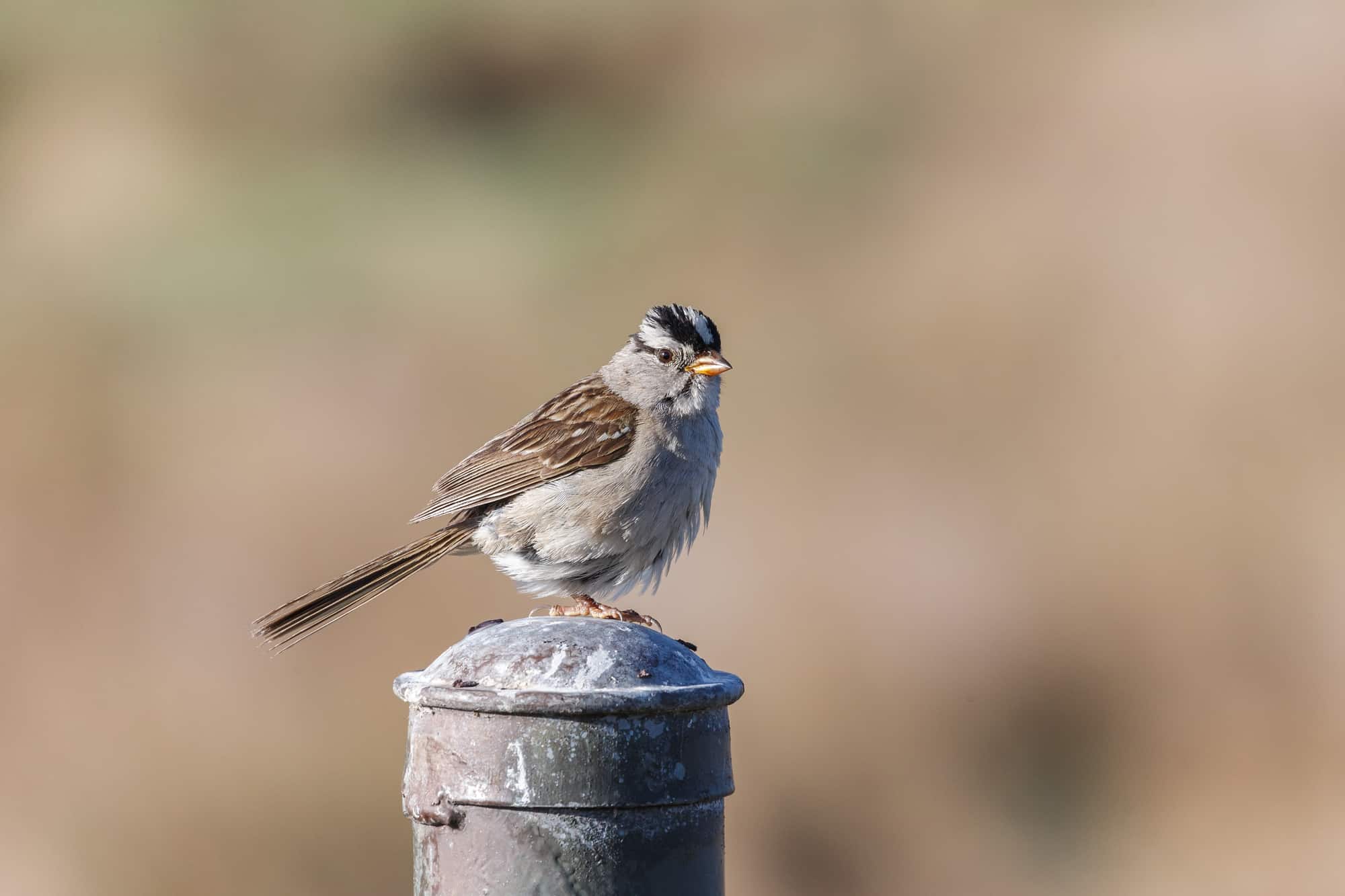
- Zonotrichia leucophrys
- ORDER: Passeriformes
- FAMILY: Passerellidae
- Length: 5.9-6.3 in (15-16 cm)
- Weight: 0.9-1.0 oz (25-28 g)
- Wingspan: 8.3-9.4 in (21-24 cm)
White-Crowned Sparrows are another larger sparrow. They have a long tail and a small bill. Their head shape changes based on their demeanor; sometimes they have a peaked crest, but other times, their head is flat and smooth.
They have a generally plain appearance at first glance, but they do have some distinctive characteristics: white and black stripes on the head, a yellow or pink bill, and a rounded body.
They are widespread across North America, often visiting birdfeeders. They are commonly found in New Hampshire during their migration windows in the spring and fall. There is nowhere in New Hampshire that they stay year-round or for the winter.
Ready To Go Find Some Sparrows in New Hampshire?
With so many incredible birds in New Hampshire, you are almost always guaranteed to see an interesting specimen when you are birding in the Granite State.
That includes all of these delightful sparrows! With a little practice, you will soon be able to differentiate between many kinds of sparrows.

